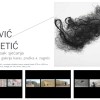Exhibition: Irena Kojkova Pejović and Ana Sladetić – Memory Between Impression and Imprint
 Irena Kojkova Pejović and Ana Sladetić
Irena Kojkova Pejović and Ana Sladetić
Memory Between Impression and Imprint
3.9. – 14.9.2013.
Opening of the exhibition on Tuesday, September 3rd 2013 at 8 pm.
CRO
Karas Gallery
Praška 4
10000 Zagreb
Opening hours:
Tuesday – Friday 11 am – 7 pm
Saturday and Sunday 10 am – 2 pm
Closed on Mondays and holidays.
Foreword: Antonia Došen
Baroque ladies, in the spirit of their time, kept their memorabilia in a form of messages on the handkerchief, collected pebbles or shells, hidden in cabinet drawers. Those were the “keepers” of their memory. Just like them, Irena Pejovic and Ana Sladetić, not only preserve their memory, but they present it its material form. But, how can we materialize memory? Ana wants, instead of
taking a picture of a particular place, to bring with her that felt/touchy feeling of the perceived space. She takes the feeling, and imprints it into her “mental closet of memories”. By imprinting the texture of the experienced space, she wants to “touch” her memories. Unlike her, Irena wants to preserve memory in situ (in its present form). This implies to creating the memory on the spot, in the process of printing. By printing two prints at once, one print becomes a memory of the other. By repeating this process, she creates a “fine clutter” of memories – individual experiences from one object to the other. Both artists use ready made materials in their work, with minimal or no intervention on their end. With this, they liberate from eclecticism and tradition, and unfettered push the boundaries of their own observations to part from learned academic form. Here, it’s not important how perfect the imprint is or the form, but the research and the process of making the print.
Ana Sladetić is oriented to preserving the memory in its physical form. She takes its measure. She uses frotage technique (rubbing) to make an impression of the place of visit. In this case, it’s about three walls. Their importance is as much as Ana gives them, the memory of them is limited by her will. Her works, by their reminiscence names Memory I, II and III, consist of video recordings of her performance, taking imprints of the walls in frotage technique. The Great Wall of China, The Berlin Wall and The Atlantic Wall are the carriers of Ana’s concept of imprinting memory. The distorted reality of the wall’s surface becomes a symbol of the same real surface – an abstract mark – Ana manages to preserve her memory in a texture that is rubbed off the walls surface. The imprints act like a cryptogram of her memories, which are read out with the help of visual recordings. Using a wall whose symbolic meaning is bearer of national identity and the real meaning of it is separating space, has no pretentious place in this work, Ana selectively collects memories of the people who created it, leading to the question “How can we preserve memory?”.
The antithetic term for Fine Clutter is about the artist’s personal experience of the materials used, and that creative chaos purified through imprinting it on the paper. In Irena Pejovic’s monotypes, we feel a strong urge for research and innovation, which reflects from the use of a very unconventional material – hair. Polymorphism of the hair enables multiple studies in making of the prints. Working with the human body in her earlier work, Irena attempts to capture its energy and movement by dematerializing the process, which brings her to its abstract form. Here, in a similar way she transforms part of the human body – the hair, preserving its memory in its present form. Looking at how the hair as an object behaves and changes in the process of printing, she pushes it thru several layers, and creates a new perception of the reality when printed. In some of the works, Irena Pejovic uses Chine-collé technique, but only to preserve its memory. She then removes the chine-collé, and this creates a memory of it, a ghost print left on the base paper. By tearing rice paper, and printing two sheets at once simultaneously, she creates a memory of one print to another, resulting in a new moment/object.
Antonia Dosen
This exhibition is realized thanks to the support of the Ministry of Culture of the Republic of Croatia and European Cultural Foundation.



